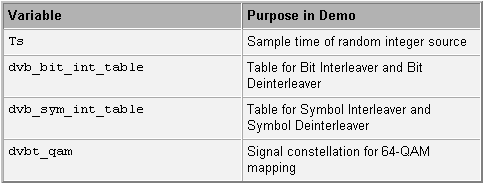Digital Video Broadcasting - Terrestrial
This example shows part of the European Telecommunications Standards Institute (ETSI) EN 300 744 standard for terrestrial transmission of digital television signals. The standard prescribes the transmitter design and sets minimum performance requirements for the receiver.
Example Structure
The example:
Presents a model,
commdvbt, of the DVBT transmitter in its 2k mode, as prescribed in the standard, and a possible receiver designGenerates error statistics that will help determine whether the receiver model satisfies the performance requirements
Presents an alternative model,
commdvbt_alt, with the DVB-T 64-QAM Demapper subsystem modified to compute exact bitwise log-likelihood ratios (LLRs) by using a Rectangular QAM Demodulator block
Using a list and a schematic, the standard shows the major processes that the data undergoes. The top row of blocks in the commdvbt model mimics the structure of the transmitter schematic. Subsystems in the commdvbt model perform major processes.

This table lists subsystems and corresponding processes from the schematic.

The bottom row of icons in the model represents subsystems that make up the receiver. The model also includes a source of random data, a channel model, error statistic calculators, and several sinks.
Variables in the Model
The model uses variables as listed in this table.

The commdvbt_tablegen helper file computes the values of these variables.
Design of the Receiver
The standard does not specify how to implement the receiver, although some inverse operations, such as deinterleaving, are clearly defined. This example illustrates a possible receiver design by using these features:
A 64-QAM demapper that makes soft decisions, producing a set of six real numbers for each complex number in its input. These six numbers represent soft decisions on the real and imaginary components' first bit, second bit, and third bit. The Viterbi Decoder subsystem interprets the soft-decision numbers and uses them to decode the punctured convolutional code properly. To examine the exact mapping more closely, see the DVB-T 64-QAM Demapper subsystem, as well as the
dvbt_qamvariable.A traceback depth of 136 in the Viterbi Decoder block. This block appears within the top-level Viterbi Decoder subsystem.
Receive delay calculation
The DVB-T inner interleaver and deinterleaver contains the following frame size rebuffering and the corresponding delays:
2176 to 756 resulting in 756 sample delay
756 to 9072 resulting in 9072 sample delay
9072 to 756 resulting in 0 sample delay
756 to 2176 resulting in 2176 sample delay
This results in a delay of 12004 samples. Since 2176 is the input frame size to the Viterbi decoder mod(12004,2176) results in a delay of 1124 which corresponds to 1124*3/4 = 843 samples due to rate 3/4 coding. With a traceback depth of 136, the Viterbi decoder also adds a further delay of 136, bringing the total delay to 843+136 = 979. In order to align the actual codewords before feeding into the convolutional deinterleaver an extra delay of 1632-979 = 653 samples is added. Rate 3/4 coding also causes the 12004 delay to manifest as 12004*3/4 = 9003. Thus the total delay for the model excluding convolutional interleaving/deinterleaving is 9003+136+653 = 9792 which is equal to 6 frames as the frame size at the 'inner' Error rate calculation block is 1632.
Convolutional interleaving/deinterleaving with 12 rows of shift registers adds a delay of 11 frames. Due to this the receive delay for the 'outer' error rate calculation block is a total of 6 + 11 = 17 frames.
Results and Displays
To examine the performance of the example, use the sink blocks that are included in it, listed in this table.


Set the simulation parameters for the next display:

Digital Video Broadcasting-Terrestrial, Alternate Form
The commdvbt_alt model illustrates an alternative way to model the 64-QAM Demapper in the receiver.

To see how the alternative version implements the 64-QAM Demapper, compare the alternative DVB-T 64-QAM Demapper subsystem in the commdvbt_alt model with the original DVB-T 64-QAM Demapper subsystem in the commdvbt model.
commdvbt — In the original model, soft decisions are computed using a subsystem-based implementation. In-phase and quadrature phase signal components are extracted after appropriately scaling the received signal, and then they are shifted to obtain soft decisions for various bits.
commdvbt_alt — In the alternative model, a Rectangular QAM Demodulator block is configured to compute exact bitwise LLRs. Noise variance needs to be provided and it is computed using the received signal and the signal generated by the DVB-T 64-QAM mapper. This approach makes derivation of soft decisions easy for any signal constellation through the use of the built-in block.
Supporting Files
The example uses this helper file and models
commdvbt_tablegen.m— Helper file to compute variables used by models in the examplecommdvbt.slx— Model of a DVBT transmitter configured for 2k mode and a possible receiver designcommdvbt_alt.slx— Alternative model with the modified DVB-T 64-QAM Demapper subsystem to compute exact bitwise log-likelihood ratios (LLRs) by using a Rectangular QAM Demodulator block
Selected Bibliography
ETSI Standard EN 300 744: Digital Video Broadcasting (DVB); Framing structure, channel coding and modulation for digital terrestrial television, European Telecommunications Standards Institute, Valbonne, France, 1997.